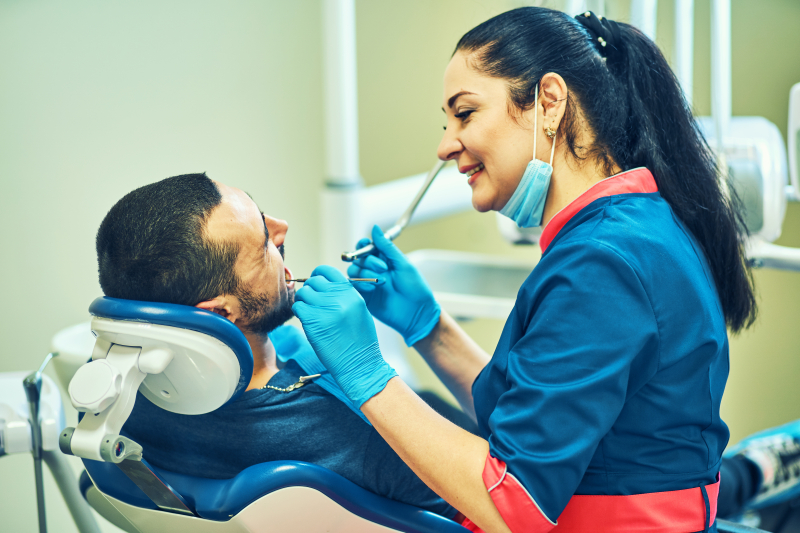Dental practices face unprecedented challenges – from rising costs and insurance complexities to regulatory changes, technological advancements, and evolving patient expectations. This has impacted dental office revenue. Dental billing practices are increasingly relying on outsourced dental billing services to manage these challenges, enhance patient care, and grow revenue.
One strategy that dentists can take advantage of to boost revenue is billing medical insurance for dental procedures. Medical plans often reimburse procedures that dentists routinely perform when the services are considered medically necessary. While improving the practice’s bottom line, billing dental services to medical plans can help patients with complex issues get the comprehensive care they need in a cost-effective manner.
Get comprehensive dental billing solutions!
Billing Medical Insurance for Dental Procedures
Integrating medical and dental is an important consideration in the coordination of care and improving patient outcomes under the Affordable Care Act. Dental insurance plans have a low annual maximum benefit. When treating a patient who has medical and dental issues that are related, the dentist can bill the patient’s medical insurance for the procedure. This will reduce financial stress for patients by maximizing their insurance coverage.
Medical insurance plans typically cover treatment provided by dentists as medical procedures, not dental procedures. The key to successful dental medical billing is knowing when a dental procedure is considered medical and billable to medical insurance. Here are three key considerations:
- The service must have been provided to treat a diagnosed medical condition: Medical insurance will pay for a procedure if it is necessary to treat a diagnosed medical condition. All dental offices can bill medical insurance for evaluations, diagnostic procedures, and surgical services to diagnose or treat medical conditions. Billing medical insurance for dental procedures involves showing how a dental procedure is connected to a medical condition. This means explaining how the medical issue, like an injury, disease, or surgery, has impacted the patient’s dental health and why the dental treatment is medically necessary as part of their overall care.
- The procedure should be medically necessary: Medical plans pay for procedures that are medically necessary, that is, when the patient has a medical condition that impacts the problem that the dentist treats. For e.g., if a patient with uncontrolled diabetes needs emergency oral surgery for acute infection, dental procedures would need to be modified and the claim can be submitted to the patient’s medical plan.
- The procedure should have a corresponding medical code: For billing dental procedures to medical insurance, the treatment must be linked to a medical condition and have a corresponding medical code. This ensures the procedure is classified correctly under medical insurance guidelines, showing its relevance to the patient’s overall health.
Dental Procedures Billable to Medical Insurance
There are specific categories of dental procedures that may be billed as medical (www.dentistryiq.com). Before billing the treatment to medical, a dental billing service provider will make sure that it falls under one of the following 4 categories:
Diagnostic procedures—This includes any service to diagnose a medical condition such as examinations, consultations, medical x-rays and scans, stents, and testing to discover the sources of pain. For instance, x-rays to identify the source of tooth pain is a diagnostic procedure.
Non-surgical medical treatments—Dentists can bill non-surgical treatments used to treat a diagnosed medical condition covered by the medical plan. Examples include TMD orthotics and sleep apnea, emergency treatments for infection or inflammation, incisions and drainage of abscesses, custom home fluoride trays for patients undergoing cancer treatment.
Surgical procedures—Medical insurance will cover some types of oral surgeries, such as those to correct a non-dental physiological condition which results in a severe functional impairment. One example is a complicated wisdom tooth surgery that may require more than standard dental procedures to complete. If the procedure requires general anesthesia, it may be billed to the medical plan. Other surgical procedures covered include soft and hard tissue biopsies, such as the excision of cysts and tumors of the maxilla, mandible and surrounding tissues. Extractions and placement of dental implants are also usually covered though tooth root replacement falls under what is allowable by a patient’s medical plan.
Treatment for traumatic injuries—Traumatic injuries are those that require immediate care. Such injuries include motor vehicle collisions, sports injuries, falls, natural disasters and other physical injuries that can occur at home, on the street, or while at work. Dentists can bill medical insurance for treating traumatic injuries that are covered by medical plans. Coverage for the injury will include all treatments that restore the original look and function of the mouth, including restorative care, endodontic treatments, surgery, implants, and prosthodontics.
Here is a list of procedures that dentists can bill to medical insurance:
- Head and neck evaluations for orofacial medical problems
- Panoramic x-rays
- CT scans
- TMJ services
- Bone grafts
- Cyst removal
- Implants
- Alveoloplasty
- Sinus lifts
- Dental implants
- Dental repair of teeth due to injury
- Sleep apnea and/or mandibular repositioning appliances & services
- Treatment related to inflammation and infection
- Certain periodontal surgery procedures
- Treatment to correct congenital malformations
- Frenectomy (tongue surgery) for infants and children
- Extraction of wisdom teeth, under certain conditions
- Removal of multiple teeth at one time
- Infection is not treatable by entry through the tooth
- The pathology that involves soft or hard tissue
- Procedures to correct dysfunction
- Emergency trauma procedures
- Consultation for an excisional biopsy of oral lesions
- Dental disease secondary to cancer treatment (e.g., mucositis and stomatitis
Know What May Not Be Covered
When billing medical insurance, dental offices should also know what may not be covered:
- Routine dental care: Cleanings, fillings, and standard check-ups are usually considered dental-only and not covered by medical insurance.
- Cosmetic procedures: Treatments like teeth whitening or veneers, which are not medically necessary, are generally excluded.
- Orthodontic treatments: Braces and aligners are rarely covered unless tied to a medical condition, such as jaw misalignment affecting function.
- Standalone tooth extractions: Unless linked to a medical issue like trauma or infection affecting overall health, these are often excluded. For traumatic injuries covered by liability insurance, that insurance should be billed before billing medical insurance
- Periodontal maintenance: Routine gum care without a direct medical condition is typically covered under dental, not medical insurance.
Know the Codes
A crucial factor in successful claims submission is mastering dental-medical cross-coding. This process involves using medical codes to represent dental procedures, ensuring they align with medical insurance requirements. Proper cross-coding demonstrates the medical necessity of the dental treatment, increasing the likelihood of claim approval. Always report what you do using the most accurate code to describe the procedure performed. It is essential that only procedures and diagnoses supported by the clinical documentation be reported. When submitting claims to a medical plan, dentists should also know payer rules:
- CDT: The CDT code set is used when reporting dental procedures to a dental payer. Many medical payers will accept the CDT code when there is no appropriate medical cross code (CPT) or when the CDT is the most accurate code to describe the dental procedure performed. Before claim submission, determine if the payer allows the submission of CDT codes.
- Use the correct ICD-10, CPT, and HCPCS Use the appropriate ICD codes to report diagnoses, symptoms and procedures and communicate to the payer why a procedure may be medically necessary. Report the latest procedure codes to describe all therapeutic/medical, and surgical treatments. For dentists, the HCPCS code set is used to report durable medical equipment such as oral sleep apnea and temporomandibular joint disorder appliances. The appropriate modifier or qualifier should be used when required.
Category I codes CPT codes are used in dentistry. Category I CPT codes are divided into six sections:
- Evaluation and management: 99202-99499
- Anesthesia: 00100–01999; 99100–99150
- Surgery: 10000–69990
- Radiology: 70000–79999
- Pathology and laboratory: 80000–89398
- Medicine: 90281–99099; 99151–99199; 99500–99607
- Ensure proper documentation: In addition to the ICD-10 codes, every claim should be submitted with documentation supporting the medical necessity for the need for the surgery in an inpatient setting. Claims without such proof of medical necessity will be denied. If the dental procedure is not the primary procedure performed, the patient’s medical records must include documentation of the primary procedure. Make sure that the documentation is legible, relevant and sufficient to validate the services billed.
- When billing Medicare, use the CMS-1500 Health Insurance Claim Form.
Know Insurer Rules
Not all medical plans cover dental benefits. Every plan that does will publish the dental procedures they will specifically cover. Policies vary based on individual plans and also depending on the state. Plans will have their own rules regarding coverage of medical services by dentists and knowing these rules is an essential for accurate claim filing.
As medical billing uses CPT and ICD-10 codes and is different from dental billing that uses CDT codes, there is a learning curve. Staying up to date with payer rules is critical to accurate claim submission. Being aware of what the patient’s medical plan will allow for dental procedures and billing the procedures correctly is critical for appropriate reimbursement. Insurance companies will reject incorrectly filed or coded claims.
Practices can reach out to a dental billing company to determine whether to file a medical or dental claim. These companies also provide dental insurance verification services, which can determine whether procedures to be done are medically billable under the patient’s plan. By filing accurate claims using the correct codes, experts can help you boost practice revenue while ensuring patients have access to the dental care they need.
Reduce administrative burden with our customized dental billing solutions!




